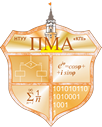- For students
- Final assessment
- Requirements for Bachelor's theses
Requirements for the structure and content of a bachelor's thesis
The requirements for the structure and content of a bachelor's degree thesis are set out in the Regulations on the final certification of students of NTUU "KPI". On the basis of these requirements, the Department of Applied Mathematics has developed refined requirements that take into account the specifics of the speciality.

- General information
The textual part of the thesis should reveal the creative intent of the work in a concise and clear form. It should contain the statement of the problem of the thesis, an analysis of the current state of the problem area, methods of solving the problem, justification of their optimality, a description of the constructed mathematical model, developed software, experiments, analysis of their results, and conclusions.
The text part should also contain the necessary tables, figures, etc. It should be free of commonly known provisions, unnecessary descriptions, derivation of complex formulas, etc.
The textual part of the thesis should be formatted in accordance with the requirements set out on the page "Requirements for Documentation" (but see below for templates).
The approximate length of the thesis should be 50-70 pages (excluding appendices).
- Structure of the thesis
A bachelor's thesis consists of the following elements:
- a cover sheet of the prescribed form (see below for design templates)
- "Task for the thesis" of the established sample (see below for templates)
- "Abstract" (in Ukrainian)
- "Abstract" (in English)
- "Table of contents"
- "List of symbols, abbreviations and terms"
- "Introduction"
- sections
- "Conclusions"
- "List of references"
- appendices
- Cover page
The cover page should be designed according to the template at the end of this page. At the same time:
- in the column "Admitted to defence", indicate the year of defence
- in the "Supervisor" field, indicate the position, academic degree, academic rank, surname and initials of the thesis supervisor. Information about the positions, academic degrees, academic titles of the department's lecturers can be found on the "Lecturers" page
- below the supervisor, on separate lines, indicate the positions, academic degrees, academic titles, names and initials of the consultants of individual sections of the thesis (if any)
- in the field "Consultant on normative control" you need to specify the senior lecturer Malchykov V. V.
- in the "Reviewer" field, indicate the position, academic degree, academic title, surname and initials of the reviewer of the thesis.
- Assignment for a thesis
The "Thesis Assignment" should be completed according to the template provided at the end of this page. At the same time:
- in the "APPROVED" column, you must indicate the year of approval of the thesis assignment. In the summer session of 2020, you must specify 2020
- in the first paragraph, indicate the topic of the thesis, surname, name, patronymic (in full), academic degree, academic title of the thesis supervisor, as well as the details of the order by which they were approved.
- in the second paragraph, the deadline for submitting the bound work to the department should be indicated.
- in the paragraph "Initial data for the work" it is necessary to indicate quantitative/qualitative indicators of the conditions, means and methods that characterise the focus of the study, specify the methodology for solving the problem and conducting the experiment
- in the paragraph "Content of the work", you need to specify the tasks for individual parts of the thesis. These tasks should be formulated in the imperative mood, starting with the words "develop", "perform", "analyse", "conduct", etc.
- in the item "List of illustrative material", the names of the key figures for the thesis and the slides of the presentation that the student will make during the thesis defence should be indicated
- in the item "Consultants of the work sections", the names of the sections, as well as the names, initials and positions of the consultants of these sections should be indicated in separate lines of the table (if available, otherwise this item can be omitted). It is worth noting that the compliance consultant is a consultant for the entire work, not for individual sections, so it is not necessary to indicate it in this paragraph
- in the "Date of assignment" item, you need to specify the date when the student was given the assignment for the thesis.
In the "Timeline", the stages of the thesis and the deadlines for their completion should be presented in tabular form. The "Note" column can be left blank.
- Abstracts
The "Abstract" should briefly reflect the general characteristics and main content of the thesis. The length of the Abstract should be at least 650 characters (with spaces).
- The "Abstract" should be completed in accordance with the following structure:
- information about the volume of the thesis (WITHOUT appendices), the number of figures, tables, appendices and bibliographic names according to the "List of References"
- purpose of the work
- methods considered in the work, criteria for choosing the method(s) for the work, method(s) selected for use in the work
- the main results achieved in the course of the work. It is necessary to use the impersonal forms of the verb of the perfect past tense, for example, "performed", "implemented", "conducted", "designed", etc.
- information on the approbation of the results of the thesis (speeches at scientific conferences, publications in scientific journals, implementation certificates, etc.
- keywords (from 5 to 20 positions)
"Abstract" should be a translation of the abstract into Ukrainian. The length of the "Abstract" should be at least 650 characters (with spaces).
- Introduction
The "Introduction" should reflect the relevance of the work based on a brief overview of the current state of the problem area.
- Sections of the thesis
The first section of the work must be the section "Problem Statement", which must contain the purpose of the work, the tasks to be solved to achieve it, the requirements for the mathematical methods and software tools developed in the work.
In the following sections of the thesis, you should present
- an overview of existing theoretical and practical solutions on the topic of the work, criteria for selecting the method(s) to be used in the work, a comparative analysis of the solutions considered according to the relevant criteria
- description of the constructed mathematical model and method(s) for solving the problem
- description of software tools for solving the problem, including developed algorithms
- description of testing of the developed software tools
Each section of the work, except for the "Statement of the problem", should end with the subsection "Conclusions to the section".
- Conclusions
In the Conclusions, the most important results obtained in the thesis should be presented, and the qualitative and quantitative indicators of the relevant results should be indicated.
"The Conclusions should be written in the form of a numbered list, the number of items in which, as a rule, corresponds to the number of tasks set out in the Statement of the Problem.
- List of references
The "List of references" must be drawn up in accordance with the requirements set out on the page "Requirements for documentation".
The following references are NOT allowed in the References:
- references to sources that have no scientific value
- links to Wikipedia pages and similar resources that do not have a scientific review process
- sites of abstracts and other document storage that have no scientific value
- course and laboratory works
- file sharing sites (and other similar resources)
Instead of linking to a file with a scanned source, you must provide a description of the printed publication!
- Applications
The thesis must contain the following mandatory appendices, among others:
- the first appendix should be the appendix "Program Listings", which should include listings of the program code for the implementation of the mathematical models, methods and algorithms described in the work. The code of the graphical user interface may not be listed. At least 30% of the listing lines should be comments. The volume of listings should be 15-40 pages. It is worth remembering that the length of the listings does not affect the length of the thesis!
- the penultimate appendix should be the "Illustrative Material" appendix, which should include the slides of the presentation that the student will make during the thesis defence
- the last appendix, if there are relevant materials, should be the appendix "Certificates of implementation of the results of work", which should include scanned copies of certificates (acts) on the implementation of the results of the thesis. In the absence of such materials, this appendix may be omitted
- Recommendations for the Presentation
Recommendations for the Structure of Presentations for Bachelor’s Theses Related to Machine Learning Topics
Title Slide with the thesis title, student’s full name, and the name of the thesis supervisor.
Problem Statement (including Business Understanding, a description of the task from a business or scientific perspective: what the goal is, how the results will be used, and why this work is important. Key metrics should also be defined here).
Overview of the State of the Art: a review of existing models, methods, and/or software solutions.
Selection of the Model, Methods, and/or Software Solution according to the criteria and requirements formulated in the thesis (why and how the specific machine learning algorithm was chosen; optimization; feature selection methods).
Structure of the Selected or Provided Data.
Data Analysis (or Exploration) (EDA, visualization of distributions, etc.).
Data Processing (or Preparation).
Hypothesis Testing or Identification of Informative Features (if applicable) (feature creation and the reasoning behind it).
Description of the Selected Models (if applicable; preferably with a mathematical description).
Description of the Selected Methods (preferably with mathematical and algorithmic descriptions).
Software Architecture (e.g., presented as UML diagrams).
Results of Applying the Selected Models and Methods to the Selected Data. Analysis of the results obtained (reporting results based on the initially selected metrics, final model selection, optimization, and hyperparameter tuning).
Conclusions of the Work.
The number of slides per section is to be determined by the student. The presentation should be structured in such a way that the core content of the thesis can be clearly and fully conveyed within 10 minutes, without requiring the audience to subsequently review the explanatory report in detail.
- Design templates
The Department of Applied Mathematics has prepared design templates that take into account the above requirements, as well as the requirements for the design of cover sheets and thesis assignments. The current version of these templates is provided to students during their pre-diploma practice.
